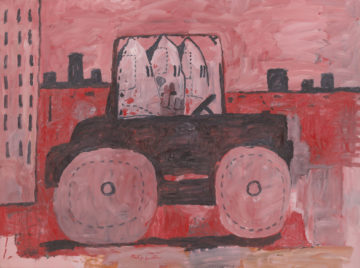Karen Wilkin at the Hudson Review:
 Restless and, at some level, always dissatisfied, in the early 1960s, Guston began to step back from his acclaimed abstractions. The floating tangles of dense brushstrokes began to coalesce into dark, confrontational, ample ovals that hovered against murky webs like surrogate self-portraits, an association reinforced by titles like Mirror, Painter, and Head. A period devoted to essentially minimal drawing followed, as if Guston were stripping everything down to essentials, testing what a single assertive mark on paper could mean. Next, he concentrated on small “portraits” of shoes, books, light bulbs, hooded figures, window shades, and the like, with every image filling the available space and pressing toward us, a series that has been described as a visual lexicon, prepared for future works. Guston later said that he was provoked to make images by the events of 1968, including the assassinations of Martin Luther King, Jr., and Robert Kennedy, student uprisings, and police brutality during the Democratic Convention. He felt that worrying about color relationships and formal issues was inadequate to the situation.
Restless and, at some level, always dissatisfied, in the early 1960s, Guston began to step back from his acclaimed abstractions. The floating tangles of dense brushstrokes began to coalesce into dark, confrontational, ample ovals that hovered against murky webs like surrogate self-portraits, an association reinforced by titles like Mirror, Painter, and Head. A period devoted to essentially minimal drawing followed, as if Guston were stripping everything down to essentials, testing what a single assertive mark on paper could mean. Next, he concentrated on small “portraits” of shoes, books, light bulbs, hooded figures, window shades, and the like, with every image filling the available space and pressing toward us, a series that has been described as a visual lexicon, prepared for future works. Guston later said that he was provoked to make images by the events of 1968, including the assassinations of Martin Luther King, Jr., and Robert Kennedy, student uprisings, and police brutality during the Democratic Convention. He felt that worrying about color relationships and formal issues was inadequate to the situation.
more here.
